List of Australian flags
This is a list of flags of different designs that have been used in Australia.
| Wikimedia Commons has media related to Flags of Australia. |
National flags
| Flag | Date | Use | Description |
|---|---|---|---|
.svg.png.webp) |
1908–present | Australian National Flag, naval jack and state ensign | A Blue Ensign defaced with the seven-point Commonwealth Star in the lower hoist quarter and the five stars of the Southern Cross in the fly half. |
.svg.png.webp) |
1903–1908 | Historic national flag as approved by King Edward VII | A Blue Ensign defaced with the Commonwealth Star (with 6 points) in the lower hoist quarter and the five stars of the Southern Cross in the fly half (all stars had seven points, except the smallest star only had 5 points). |
.svg.png.webp) |
1901–1903 | Historic flag, original 1901 Federal Flag Design Competition winner | A British Blue Ensign defaced with the Commonwealth Star (with 6 points) in the lower hoist quarter and the five stars of the Southern Cross in the fly half (each star had a varying number of points: 9, 8, 7, 6 and 5). It was first flown in Melbourne on 3 September 1901. That day is known as Flag Day. |
Other flags recognised under the Flags Act 1953[1][2]
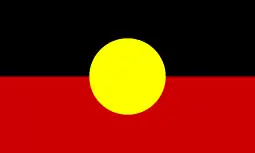 |
1971–present | Australian Aboriginal Flag | A black and red flag with a yellow circle in the middle. |
| Link to file | 1992–present | Torres Strait Islander Flag | A five-pointed star and traditional headdress in white, on a blue, green and black background. |
Personal flags
Sovereign
| Flag | Date | Use | Description |
|---|---|---|---|
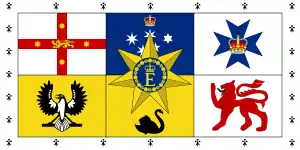 |
1962–present | Personal Australian Flag of Queen Elizabeth II |
Governor-General
| Flag | Date | Use | Description |
|---|---|---|---|
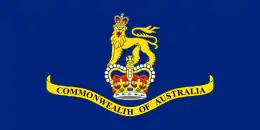 |
1953–present | Flag of the Governor-General of Australia | A crowned lion standing on a crown on a blue field. The crown used is St Edward's Crown. |
.svg.png.webp) |
1936–1953 | Flag of the Governor-General of Australia | A crowned lion standing on a crown on a blue field. The crown used is the Tudor Crown. |
.svg.png.webp) |
1909–1936 | Flag of the Governor-General of Australia | A Union Flag defaced with a seven pointed star, crowned, surrounded by ears of corn and a gold circlet. The crown used is the Tudor Crown. |
.svg.png.webp) |
1902–1909 | Flag of the Governor-General of Australia | A Union Flag defaced with a six pointed star, crowned, surrounded by ears of corn and a gold circlet. The crown used is the Tudor Crown. |
State Governors
| Flag | Date | Use | Description |
|---|---|---|---|
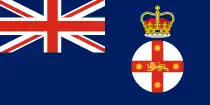 |
1981–present | Flag of the Governor of New South Wales | The State Flag with a crowned badge. |
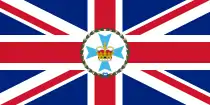 |
1876–present[lower-alpha 1] | Flag of the Governor of Queensland | The Union Flag defaced with the state badge. |
 |
1975–present | Flag of the Governor of South Australia | The State Flag with a crowned badge. |
 |
1977–present | Flag of the Governor of Tasmania | The State Flag with a crowned badge. |
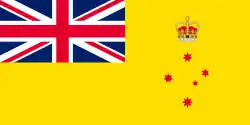 |
1984–present | Flag of the Governor of Victoria | The State Flag with a yellow field and crowned southern cross. |
 |
1988–present | Flag of the Governor of Western Australia | The State Flag with a crowned badge. |
Prime Minister
| Flag | Date | Use | Description |
|---|---|---|---|
.svg.png.webp) |
1950s–1966 | Car Flag of the Prime Minister of Australia | The Australian national flag defaced with the coat of arms of Australia placed between the Commonwealth Star and the Southern Cross. Used by Robert Menzies in the 1950s and 1960s.[3][4][5] |
States and territories
States
| Flag | Date | Use | Description |
|---|---|---|---|
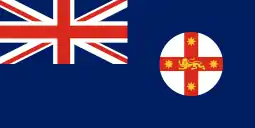 |
1876–present | Flag of New South Wales | A St George's Cross with four gold stars and a lion in the fly of a British blue ensign. |
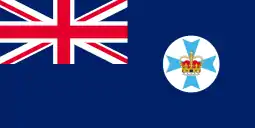 |
1876–present[lower-alpha 1] | Flag of Queensland | A light blue Maltese cross with a crown on a white background in the fly of a British blue ensign. |
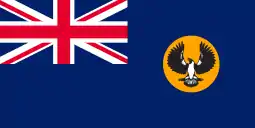 |
1904–present | Flag of South Australia | A piping shrike on a gold background in the fly of a British blue ensign. |
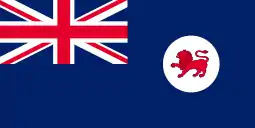 |
1875–present | Flag of Tasmania | A red lion on a white background in the fly of a British blue ensign. |
.svg.png.webp) |
1877–present[lower-alpha 1] | Flag of Victoria | The Southern Cross surmounted by a crown in the fly of a British blue ensign. |
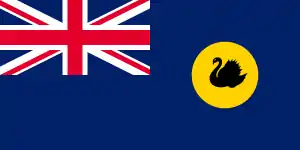 |
1953–present | Flag of Western Australia | A black swan on a gold background in the fly of a British blue ensign. |
Internal territories
| Flag | Date | Use | Description |
|---|---|---|---|
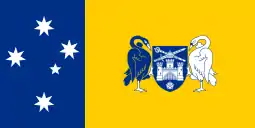 |
1993–present | Flag of the Australian Capital Territory | One third blue with the Southern Cross, the other two thirds are yellow with the Coat of Arms of Canberra. |
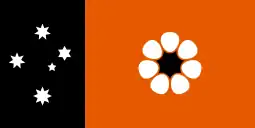 |
1978–present | Flag of the Northern Territory | One third black with the Southern Cross, the other two thirds are brown with Sturt's Desert Rose, the floral emblem of the Territory. |
External territories
| Flag | Date | Use | Description |
|---|---|---|---|
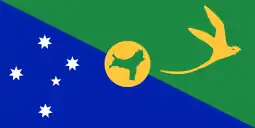 |
2002–present | Flag of Christmas Island | The blue and green diagonal panels represent the sea and the island's vegetation, a small map of the island is included in the centre. The main emblem is a golden bosun bird. The flag was selected from a competition held in 1986 and was approved in 2002. |
_Islands.svg.png.webp) |
2004–present | Flag of the Cocos (Keeling) Islands | The flag is green, with a palm tree on a gold disc in the canton, a gold crescent for the Cocos Malay people in the centre of the flag and a gold southern cross in the fly. The flag was designed in 2003 becoming official in 2004. |
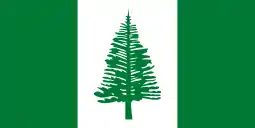 |
1980–present | Flag of Norfolk Island | A green field with a white square containing a green Norfolk Island pine. |
Civil ensigns
| Flag | Date | Use | Description |
|---|---|---|---|
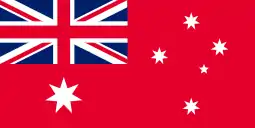 |
1909–present | Australian Red Ensign | A British Red Ensign with the Commonwealth Star at the hoist, and the Southern Cross in the fly half. |
.svg.png.webp) |
1903–1909 | Red Ensign as approved by King Edward VII | A Red Ensign defaced with the Commonwealth Star (with 6 points) in the lower hoist quarter and the five stars of the Southern Cross in the fly half (all stars had seven points). |
.svg.png.webp) |
1901–1903 | Red version of the 1901 Federal Flag Design Competition winner | A British Red Ensign defaced with the Commonwealth Star (with 6 points) in the lower hoist quarter and the five stars of the Southern Cross in the fly half (each star had a varying number of points: 9, 8, 7, and 6). |
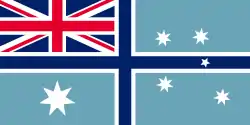 |
1948–present | Australian Civil Air Ensign | Based on the British Civil Air Ensign, with the addition of the Southern Cross and Commonwealth Star in white. |
.svg.png.webp) |
1935–1948 | Australian Civil Air Ensign | Based on the British Civil Air Ensign, with the addition of the Southern Cross and Commonwealth Star in yellow. |
Australian Defence Force
| Flag | Date | Use | Description |
|---|---|---|---|
| Link to file | 2000–present | Australian Defence Force Ensign | A tricolour of dark blue (navy); red (army) and light blue (airforce) with the Triservice badge. |
Royal Australian Navy
| Flag | Date | Use | Description |
|---|---|---|---|
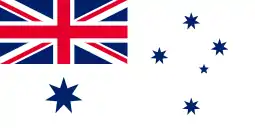 |
1967–present | Australian White Ensign | Based on the British White Ensign, a version of the national flag with a white field and the Commonwealth Star and the Southern Cross in blue. |
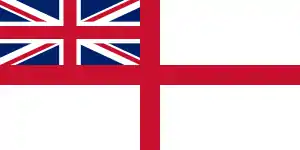 |
1911–1967 | Royal Australian Navy Ensign | St George's Ensign or White Ensign: white field defaced with a thin Cross of Saint George, Union Flag in the first quarter. It was replaced by the Australian White Ensign. |
 |
1920–present | Flag of the Chief of Navy | A fouled anchor on a red-blue background. |
| Link to file | 2001–present | Australian Navy Cadets Ensign | A blue ensign with the Australian White Ensign in canton and the badge of the Australian Navy Cadets in the fly. |
 |
1972–2001 | Naval Reserve Cadets Ensign | A blue ensign with the Australian White Ensign in canton and the badge of the Naval Reserve Cadets in the fly. Replaced by the Australian Navy Cadets Ensign. |
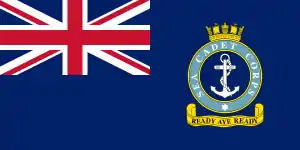 |
1956–1972 | Sea Cadet Corps | A blue ensign with the badge of the Sea Cadet Corps in the fly. Replaced by the Naval Reserve Cadets Ensign. |
Royal Australian Air Force
| Flag | Date | Use | Description |
|---|---|---|---|
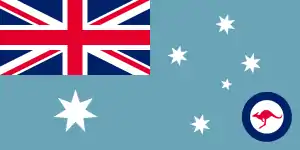 |
1982–present | Royal Australian Air Force Ensign | The national flag with a light blue field, the Southern Cross tilted and the RAAF roundel (Kangaroo) placed in the lower fly. |
.svg.png.webp) |
1948–1982 | Royal Australian Air Force Ensign | The national flag with a light blue field, the Southern Cross tilted and the RAAF roundel placed in the lower fly. |
 |
1921–1948 | Royal Australian Air Force Ensign | The British Royal Air Force Ensign. |
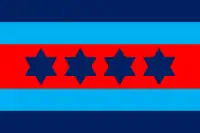 |
1982–present | Flag of the Australian Air Chief Marshal | Five horizontal stripes of dark blue, light blue, red, light blue and dark blue, four six-pointed stars in the middle stripe. |
Australian Border Force
The department names of Australia's border protection service have slightly changed over time, they are as follows;
- Department of Trade and Customs (1 January 1901 – 1956)
- Department of Customs and Excise (1956–1975)
- Department of Police and Customs (1975–1975)
- Department of Business and Consumer Affairs (1975–1982)
- Department of Industry and Commerce (1982–1984)
- Department of Industry, Technology and Commerce (1984–1985)
- Australian Customs Service (1985–2009)
- Australian Customs and Border Protection Service (2009–2015)
- Australian Border Force (2015–Present)
| Flag | Date | Use | Description |
|---|---|---|---|
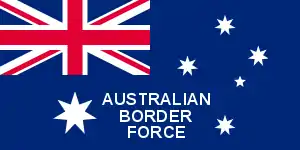 |
2015–present | Australian Border Force Flag | The Australian national flag defaced with "AUSTRALIAN BORDER FORCE" |
 |
2015 | Australian Border Force Flag as used temporarily | The Australian national flag defaced with "BORDER FORCE" |
 |
1988–2015 | Australian Customs Flag | The Australian national flag defaced with "CUSTOMS" |
 |
1909–1988 | Australian Customs Flag | The Australian national flag defaced with "HMC" |
 |
1904–1909 | Australian Customs Flag | The Australian national flag defaced with "HMC" |
 |
1903–1904 | Australian Customs Flag | The Australian national flag defaced with "HMC AUSTRALIA" |
 |
1901–1903 | Australian Customs Flag | The Australian national flag defaced with "HMC AUSTRALIA" |
Federal and state police
| Flag | Date | Use | Description |
|---|---|---|---|
| Link to file | 1982–present | Flag of the Australian Federal Police | A black-white-black vertical tricolor, with the badge of the Australian Federal Police in the centre of the white stripe. A black-and-white checkerboard borders the flag. |
| Link to file | 1981–present | Flag of the New South Wales Police Force | An azure-and-white horizontal bicolor with the badge of the New South Wales Police Force in the centre of the flag. |
| Link to file | 2006–present | Flag of the Northern Territory Police | A variant of the Northern Territory flag with the Northern Territory Police badge replacing the flower in the fly. |
| Link to file | 2006–present | Flag of the Queensland Police Service | A light blue-and-dark blue horizontal bicolor with the badge of the Queensland Police Service in the centre of the flag. |
| Link to file | 1993–present | Flag of the South Australia Police | A British Blue Ensign defaced with the badge of the South Australia Police within a white disk. |
 |
??–present | Flag of the Tasmania Police | An azure flag with the badge of the Tasmania Police in the centre of the flag. |
| Link to file | ??–present | Flag of the Victoria Police | A British Blue Ensign defaced with the badge of the Victoria Police. |
| Link to file | 2005–present | Flag of the Western Australia Police | A white flag with a stylised depiction of a swan and checkerboard in blue, with the Western Australia Police emblem added. |
Cities and areas
| Flag | Date | Use | Description |
|---|---|---|---|
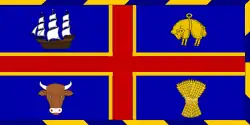 |
1982–present | Armorial Flag of the City of Adelaide | Blue background divided into four quarters by a Saint George's Cross outlined in gold overlain with the Arms of the City of Adelaide. Flag bordered on three sides by diagonal blue and gold stripes.[6] |
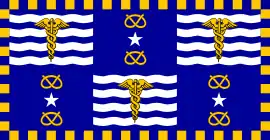 |
1947–present[7] | Flag of the City of Brisbane | Blue background (representing the Brisbane River) bordered by a golden checker pattern (representing the Sun and Brisbane's warm climate) with the flag divided into six quarters. The upper hoist quarter contains a golden caducei superimposed on wavy white lines, representing the Brisbane River and its ties to the city's commerce. The lower hoist quarter contains two Stafford knots and a white star arranged vertically (all represent the achievements in astronomy of Sir Thomas Brisbane, for whom the city is named). The remaining segments alternate between these two designs. The flag design is based on the shield on the coat of arms of Brisbane.[8][9] |
| Link to file | 2009–present | Flag of the City of Darwin | According to council policy, Darwin maintains two flags.[10] The policy reads "One flag will contain the official Coat of Arms, with its nine colours and the CITY OF DARWIN printed underneath in blue, on a yellow background flanked by red and green. The other flag will contain the City Logo and be in the colours of blue, green and white, on a white background."[11] |
| Link to file | Flag of the City of Hobart | The flag of Hobart City Council, of Tasmania, Australia. Designed in 1951 by Hobart architect and alderman, I.G. Anderson and first flown in 1953.
The star is derived from the arms of Lord Hobart, 4th Earl of Buckinghamshire (1760–1816), Secretary of State for War and the Colonies at the time of colonial settlement (1804), and after whom Hobart is named. The colour used on the arms Lord Hobart was, in fact, sable (black), rather than blue. The red lion is from the Tasmanian flag – and its location at the top of the shield signifies Hobart's position as the Capital City.[12] | |
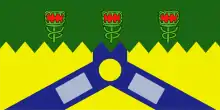 |
Flag of the City of Launceston | The Launceston flag design is based on the city's Coat of Arms granted by the College of Arms, London on 11 June 1957.[13] The Brisbane Street Mall, the War memorial at Royal Park, the original Queen Victoria Museum (now the Art Gallery) building, atop the Council Chambers and on top of the Albert Hall are places in the city where the flag is regularly flown. The three intersecting lines in the flag represent the city's three rivers (North Esk, South Esk and Tamar) and the two rectangles in the lines represent tin ingots. The strip across the top with the jagged edge is green to represent the city's parks, gardens and surrounding countryside. Waratah flowers at the top symbolise all flowers and similar beauties of nature. The ingots are included because Launceston used to be a large tin smelting centre. The little circle at the river junction is Launceston. | |
 |
Flag of the City of Melbourne | White background divided into four quarters by a Saint George's Cross outlined by a concise and overlain with St Edward's Crown. Quadrant features represent the main activities of the economy of the City of Melbourne in the mid 19th century and are, in a clockwise direction from top left, a fleece hanging from a red ring (wool), a black bull standing on a hillock (cattle), a three-mast ship in full sail (shipping), and a spouting whale in the sea (whaling). The flag design is identical to the shield on the coat of arms of Melbourne.[14] | |
 |
1961–present | Flag of the City of Newcastle | The colours are brown over green, taken from the shoulder patch of a Battalion raised in the Newcastle/Hunter region. The shield has a gold chief, containing a black diamond, a white sheep's fleece banded gold and a black wheel, representing the principal pursuits of the area: coal mining, farming and grazing, and industry and trade. Below this, the field is green, with a blue downward pointed triangle (pile) bordered gold, portraying a port with the waters of the sea thrusting into the green land. Fertility is emphasised by the gold border. The crest is a lighthouse, for the Nobby's Head lighthouse at the entrance to the harbour, and sits on a helmet with mural crown (city status) and blue, green and gold mantling. The arms stand on a compartment depicting the golden sand and white waves of the city's beaches (with a scroll inscribed "Enterprise") and are supported by two seagulls with mural crowns (the setting and nature of the city).[15] |
 |
1949–present | Flag of the City of Perth | Saint George's Cross overlaid with the City of Perth Coat of Arms in the centre.[16] |
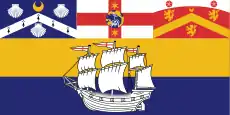 |
1908–present | Flag of the City of Sydney | The flag is a horizontal triband of three colours – white, gold and blue. The top third features three designs. In the top left the arms belong to Thomas Townshend, Viscount Sydney, after whom the city was named. The English Naval Flag in the centre acknowledges the role Arthur Philip played in Sydney's foundation. The red cross is overlaid with a globe and two stars – the principal features of James Cook's Arms, which were granted as a posthumous honour for his service in mapping Australia. The arms in the top right belong to the first Lord Mayor of Sydney, Thomas Hughes. It was during his term of office that the title of Mayor became Lord Mayor, and the official coat of arms for the city was granted. The remaining field of the flag features a ship under full sail, an allusion to the prominence of Sydney as a maritime port.[17] |
| circa 1960–2008 | Flag of the City of Toowoomba | The flag of Toowoomba city is a violet coloured ensign which makes reference to the city's floral emblem of the day, the Toowoomba Violet (aka the sweet violet, Lat. 'Viola odorata').[18]
Notable is the city's coat of arms [19] in the centre of the ensign and the city's name on the left of the flag, lettered from top to bottom.[20] | |
| 2008–present | Flag of Toowoomba | A new Toowoomba flag was created in 2007 and became the official flag of the Toowoomba Region on 15 March 2008 with the amalgamation of 8 councils; The councils were Clifton Shire, Crows Nest Shire, Cambooya Shire, Jondaryan Shire, Millmerran Shire, Pittsworth Shire, Rosalie Shire and Toowoomba City.[21]
The predominant colours are white and teal. The three white rings in the flag intersect to create eight spaces from their loops and exterior, symbolising the unity of the eight amalgamated former councils. The colour of teal also respresents unity.[22] | |
| Link to file | 1965–present | Flag of Wagga Wagga | Officially, the Wagga Wagga City Flag is square.[23] The upper quarter of the flag contains eight stalks of wheat positioned so as to form two capital letters W on a vert (green) field. The lower quarter of the upper half of the flag contains a wavy blue line on gold (yellow) representing the river winding through the wheat fields. The lower half of the flag contains the head of a ram positioned centrally on a vert (green) field. |
.svg.png.webp) |
1850–present | Upper Murray River Flag | Flown by vessels on the upper reaches of the Murray River, predominantly in Victoria. The blue bars are said to represent the four major rivers that form the Murray-Darling River system and their dark hue represents the darker colour of the Murray River's darker waters in Victoria and NSW. |
.svg.png.webp) |
1850–present | Lower Murray River Flag | Flown by vessels on the lower reaches of the Murray River, predominantly in South Australia. The blue bars are said to represent the four major rivers that form the Murray-Darling River system and their light hue represents the lighter colour of the Murray River's lighter waters in South Australia. |
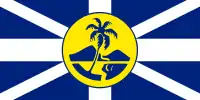 |
1998–present | Flag of Lord Howe Island, New South Wales | Despite being an unofficial flag of a state-integrated island, it is used to represent the island. |
Religious flags
| Flag | Date | Use | Description |
|---|---|---|---|
 |
Flag of the Anglican Church of Australia | A red St. George's Cross bordered in white, on a field of dark blue, with four white eight pointed stars in each of the four quarters. In the centre is a gold bishop's mitre. | |
 |
Flag of the Grand Orange Lodge of Australia | An orange ensign with the Australian flag in the canton and an open book surmounted by a Saint Edward's Crown in the lower fly. | |
 |
Flag of the Loyal Orange Institution of Victoria | An orange ensign with a Saint George's Cross in the canton, and a Southern Cross with a Saint Edward's Cross above it and an open book below it in the fly. |
Historical flags
| Flag | Date | Use | Description |
|---|---|---|---|
.svg.png.webp) |
1788–1801 | Union Flag | The Union Flag of the Kingdom of Great Britain. Raised by Captain Arthur Phillip RN on 26 January 1788 at Sydney Cove upon the landing of the First Fleet. |
 |
1801–1903 | Union Flag | The Union Flag of the United Kingdom. |
| 1806 | Bowman Flag | A white swallow-tail fly, with a crest featuring the Rose of England, the thistle of Scotland and the shamrock of Ireland supported by an emu and kangaroo. The design was an inspiration for Australia’s National Coat of Arms. | |
 |
1823/24–1831 | National Colonial Flag for Australia | A British White Ensign, featuring four white stars on the red cross |
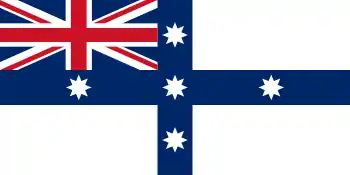 |
1830s–1920s | Australian Federation Flag | A British White Ensign, featuring the cross in blue with five white stars. It was the de facto flag of Australia from 1 January 1901 to 3 September 1901. |
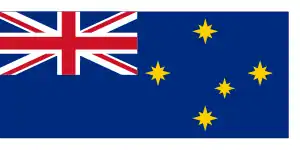 |
1849–1853 | Australasian Anti-Transportation League Flag | British Blue Ensign, with yellow Southern Cross and white border, to which branch names were added |
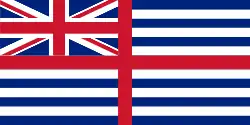 |
1850s–1875 | Van Diemen's Land Ensign | A British White Ensign, featuring six blue bars |
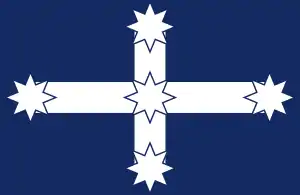 |
1854 | Eureka Flag | The battle flag of the Eureka Stockade featured the five stars of the constellation Crux Australis in white on a white cross and blue field |
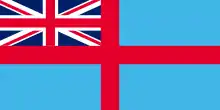 |
1859 | Queensland Separation Flag | The Queensland Separation Flag, flown on 10 December 1859 to mark Queensland becoming a separate colony from New South Wales. A red cross on a light blue field, with the Union Jack in the canton. |
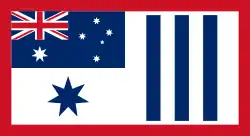 |
1918 | Australian Honour Flag | Awarded to towns who exceeded double their quota of war funding. |
| 1988 | Bicentennial Flag | The 200th anniversary of European settlement in Australia[24] | |
| 2001 | Centenary of Federation Flag | The 100th anniversary of Federation – the establishment of the Commonwealth of Australia[24] |
Sporting flags
| Flag | Date | Use | Description |
|---|---|---|---|
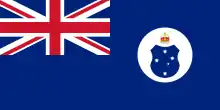 |
1908–1912 | Flag of the Australasian Olympic Team | A Blue Ensign defaced by a white circle containing the British Crown plus a shield containing the Southern Cross. |
| Link to file | 1983–present | Boxing Kangaroo sporting flag | A golden kangaroo wearing red boxing gloves on a green field. |
| 2000 | Sydney Olympics sporting flag | [24] | |
| 2006 | Melbourne Commonwealth Games sporting flag | [24] |
See also
Notes
- The rendition of the crown has changed according to the monarchs' wishes. In c. 1901 it was changed to the Tudor Crown, and in 1953 to the St Edward's Crown.
References
- PMC. "Flags Act 1953". www.legislation.gov.au. Retrieved 27 August 2020.
- Cabinet, Prime Minister and (27 June 2016). "Australian flags". www.pmc.gov.au. Retrieved 27 August 2020.
- ABC Television show "Auction Room", 11 November 2012
- Pg 207. Flags of the World, Barraclough, E.M.C., ISBN 978-0-72-322797-7
- Jonathan Dixon; Ian MacDonald. "Prime Minister – Australia". Retrieved 4 November 2015.
- "History of Council". Adelaide City Council. Retrieved 22 January 2015.
- "The city standard, but do you recognise it?". Brisbane Times. Retrieved 22 January 2015.
- "Symbols used by Council". Brisbane City Council. Retrieved 4 November 2015.
- Jonathan Dixon; Ian MacDonald. "City of Brisbane (Queensland, Australia)". Retrieved 4 November 2015.
- "Darwin (Northern Territory, Australia)".
- "Council's Symbols" (PDF). Archived from the original (PDF) on 25 May 2009. Retrieved 5 December 2016.
- "Hobart Coat of Arms – City of Hobart, Tasmania Australia". Retrieved 20 September 2018.
- "Coat of Arms". Launceston City Council. Archived from the original on 22 July 2008. Retrieved 16 August 2008.
- "Archived copy". Archived from the original on 25 January 2014. Retrieved 27 May 2014.CS1 maint: archived copy as title (link)
- "City of Newcastle (NSW, Australia)". www.crwflags.com. Retrieved 21 July 2016.
- "History of the Council". City of Perth. Retrieved 19 December 2013.
- "Sydney's flag and flower". City of Sydney. Retrieved 26 June 2015.
- "Arrowhead Voilet". Toowoomba Plants: Natives of the Region suitable for Gardens. Retrieved 7 January 2019.
- "Toowoomba". Heraldy of the World. Retrieved 7 January 2019.
- "Toowoomba Flags". toowoomba.org. Retrieved 1 January 2019.
- "Toowoomba Region Amalgamation". Toowoomba Regional Council. Retrieved 1 January 2019.
- "Toowoomba Flags". toowoomba.org. Retrieved 1 January 2019.
- "Wagga Wagga City Flag". Retrieved 3 October 2016.
- Historical Flags of Australia